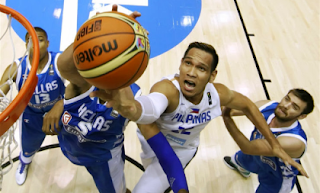After reigning back-to-back Philippine Basketball Association (PBA) Most Valuable Player (MVP) June Mar Fajardo decided to skip the national team duties to rest his injured foot, he received flak and thousands of online criticism.
Fajardo, who was named to the Gilas Pilipinas pool, said a few months ago that he will miss buildup for the 2015 FIBA Asia Championships, where the national team finished runner-up to China.
"Skip muna ako sa Gilas (I'll skip Gilas for now.)," Fajardo said in one of his interviews.
Fajardo was forced to beg off from national team duties due to plantar fasciitis on both feet, an injury he incurred through the course of the PBA season.
However, last 24 October, he led the San Miguel Beermen to a convincing win against the GlobalPort Batang Pier in the league’s first out-of-town game in Davao this season. Fajardo played for 38 minutes and tallied 21 points, 17 rebounds and 3 blocks.
This begs the question: Can you play through the pain caused by plantar fasciitis?
Plantar fasciitis appears to be a growing problem, on the court and off. With two-thirds of an aging Filipino population either overweight or obese, coupled with a propensity to wear unsupportive shoes, some practitioners have even called the foot condition an epidemic. And PBA players are not immune.
Although there are no studies looking specifically at plantar fasciitis in basketball players, practitioners point to several components, including some cited in the general population, that might explain why basketball players seem to be predisposed to this painful condition. Age, size, and repetitive movement are among the factors that can cause irritation or microtears to the band of tissue that runs along the bottom of the foot.
So what’s a PBA player to do? He may not have the luxury of resting as much as would be ideal, but there are measures that can help get him back on the floor faster, such as addressing shoe type, frequency of replacements, use of custom orthoses, and undergoing certain therapies.
In short, plantar fasciitis is not the most serious injury that PBA players can develop. It can certainly bring a halt to training, matches and, in extreme cases, even threaten a professional’s career, but there are technological innovations that can treat it temporarily, especially if one is serving their country.
One feasible option for Fajardo if he had decided to join the national teams is to use custom foot orthoses. These shoes use high-tech pressure measurement technology with Bluetooth capability to guide orthosis fabrication and assess the effectiveness of an intervention by comparing pre- and post-treatment scans.
After FIBA, rest can help sustain the effects foot orthoses. Bayan muna bago sarili (Country first before personal gratification).
Fajardo, who was named to the Gilas Pilipinas pool, said a few months ago that he will miss buildup for the 2015 FIBA Asia Championships, where the national team finished runner-up to China.
"Skip muna ako sa Gilas (I'll skip Gilas for now.)," Fajardo said in one of his interviews.
Fajardo was forced to beg off from national team duties due to plantar fasciitis on both feet, an injury he incurred through the course of the PBA season.
However, last 24 October, he led the San Miguel Beermen to a convincing win against the GlobalPort Batang Pier in the league’s first out-of-town game in Davao this season. Fajardo played for 38 minutes and tallied 21 points, 17 rebounds and 3 blocks.
This begs the question: Can you play through the pain caused by plantar fasciitis?
Plantar fasciitis appears to be a growing problem, on the court and off. With two-thirds of an aging Filipino population either overweight or obese, coupled with a propensity to wear unsupportive shoes, some practitioners have even called the foot condition an epidemic. And PBA players are not immune.
Although there are no studies looking specifically at plantar fasciitis in basketball players, practitioners point to several components, including some cited in the general population, that might explain why basketball players seem to be predisposed to this painful condition. Age, size, and repetitive movement are among the factors that can cause irritation or microtears to the band of tissue that runs along the bottom of the foot.
So what’s a PBA player to do? He may not have the luxury of resting as much as would be ideal, but there are measures that can help get him back on the floor faster, such as addressing shoe type, frequency of replacements, use of custom orthoses, and undergoing certain therapies.
In short, plantar fasciitis is not the most serious injury that PBA players can develop. It can certainly bring a halt to training, matches and, in extreme cases, even threaten a professional’s career, but there are technological innovations that can treat it temporarily, especially if one is serving their country.
One feasible option for Fajardo if he had decided to join the national teams is to use custom foot orthoses. These shoes use high-tech pressure measurement technology with Bluetooth capability to guide orthosis fabrication and assess the effectiveness of an intervention by comparing pre- and post-treatment scans.
After FIBA, rest can help sustain the effects foot orthoses. Bayan muna bago sarili (Country first before personal gratification).


No comments:
Post a Comment